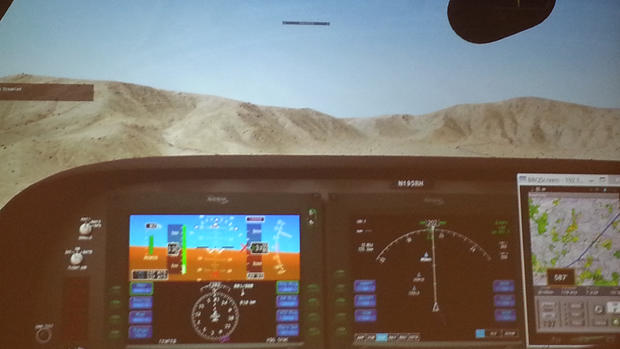NASA's Innovative Ground Collision Avoidance System Could Save Hundreds Every Year
Matt Kamlet, CBS Los Angeles
EDWARDS (CBSLA.com) — Most air travelers don't know it, but NASA is with you when you fly.
That's right — the first 'A' in NASA stands for Aeronautics, and the agency continues to develop methods to improve the safety, efficiency, and adaptability of air travel.
In fact, much of the technology seen in both commercial and private flight today, from impact-absorbing seats to the fly-by-wire system used virtually everywhere, was developed locally by NASA.
Most of the general public associates NASA almost exclusively with Low-Earth orbit, spaceflight, or ambitions of deep space exploration. However, the goal of improving flight within the boundaries of our own planet's atmosphere continue to accelerate at an exciting pace, and much of the research, testing, and execution takes place right here, in our own back yard.
The Armstrong Flight Research Center (AFRC), formerly Dryden Flight Research Center, is located about an hour and a half northeast of Los Angeles, at the historic Edwards Air Force Base. Edwards, which has served as home to specialized astronaut training for decades, including for the Apollo lunar-landings and the original Mercury Seven astronauts, continues to provide a backbone for perfecting the methods that keep us safe and improve our ability to fly.
A number of these technologies were discussed in depth at AFRC this week, with a particular emphasis on a groundbreaking new technology that could save hundreds of lives each year.
The Automatic Ground Collision Avoidance System (Auto-GCAS), developed at AFRC, is a revolutionary software that aims to greatly reduce incidents of controlled flight into terrain aircraft accidents.
These accidents represent the second leading cause of fatalities of air-related fatalities, causing about 100 deaths per year in the US. At times, pilots may become disoriented, distracted due to weather, or incapacitated due to G-forces, while an undetected obstruction becomes unavoidable.
The Auto-GCAS seeks to make these accidents a thing of the past.
The system essentially uses the aircraft's flight computer to detect the ground's approach, interpret how much time remains before impact, and initiate an auto-pilot command, which maneuvers the aircraft to avoid a crash.
NASA project manager Mark Skoog, chief engineer of the Auto-GCAS project, says that the accidents happen on a broad scale, and that the system would not act as a substitute for training, but rather, would enhance flight safety along with proper training.
"Both the civil side and the military have come to the same conclusion: that we've done everything we can with training," Skoog said at the FlyNASA Social event at AFRC. "We've got our pilots very, very well trained, and the mishap statistics are happening across the entire broad spectrum of pilot training.
"It doesn't matter if you're a new pilot or an old pilot, you've been trained about to the appropriate level to avoid these kinds of mishaps. They are more of a random occurrence."
At the event, Skoog shared a clip with social media users, showing an F-16 fighter aircraft run with a peak in the Kern Valley. In the clip, the F-16's Auto-GCAS system did not appear to interfere with the pilot as he approached an apparent collision course with the peak. Then, at a certain safe-point, the system took control of the aircraft, pulled it up just enough to avoid the collision, based on the system's detections and calculations, and then immediately gave control back to the pilot.
But what of the concern over the system's ability to interfere with the aircraft's normal flying operations?
Skoog shared the contexts integrated into the system by NASA which make the design, "nuisance-free, and, for the first time, acceptable to the pilot community."
Do No Harm
Whereas the system's original, fundamental goal was initially to avoid collision with the ground, NASA rearranged the objectives to make them safer and more practical. "The first thing we want to make sure of is that the system is not going to do anything worse than the vehicle would have already done without the system," Skoog said. This involves detection technology that prevents the aircraft from pulling away from the ground and into separate terrain or another aircraft.
Do Not Impede
The system is programmed not to interfere with normal flight operations. The primary concern was clearly that the system may detect terrain that is not there, as older software had done, and create a critical issue for the pilot. However, by prioritizing flight operations over ground avoidance, this no longer becomes an issue. "It's only if we can make sure we're not going to do any harm, and not be a nuisance, only then will we worry about providing protection," Skoog said.
Under one of the system's tests, a pilot in an F-16 intentionally flew a heading that had him on a collision course with a hill. In a demonstration of the system's design not to interfere with the pilot's flight until absolutely necessary, the pilot approached the terrain closer than he had anticipated, and took control to avoid the terrain — or so he thought.
After landing, the pilot assumed the system had failed, and that he had executed the collision avoidance maneuver himself. However, it was revealed that the system did indeed activate, 70 feet from collision, and performed the exact same maneuver the pilot would have executed, making him think he was in control.
Eventually, NASA began implementing the technology into other aircraft than military-grade fighter vehicles.
Using a 10-foot unmanned aerial vehicle presented the challenge of a slower aircraft performing an avoidance maneuver, as well as to higher susceptibility to influential elements, such as wind. The UAV was able to perform a calculated action that both safely avoided collision with the ground and put it on a safe trajectory, through an automated flight system instead of a pilot.
NASA has theorized a method, which, by Summer 2015, they expect will be able to accurately measure wind.
The true challenge of the technology was identified as the cost of its utilization, so NASA began thinking of ways to make it more economically feasible for private pilots.
"This system that you see here, that has a digital computer that can potentially host (the Auto-GCAS), is a $20,000 modification to the aircraft," Skoog said. "Most private pilots will spend every penny they can just on the basic aircraft. They can't afford that sort of thing."
Therefore, the system will reportedly be available in the form of a smartphone app. The app version is anticipated to act as a warning system, as most general aviation aircraft lack digital flight controls or a digital autopilot.
"...we found a way to push that software over to your cell phone, and that's what we're in the process of doing," Skoog stated. "We have migrated it. We've got the entire world's database on (a) chip."
Skoog says that, while an F-16 takes flight with about 91 megabytes of terrain data, which would cover roughly most of Southern California and Arizona, a different aircraft, which doesn't need to take up its memory with other, specialized integrations, can fit more.
Terrain data on a global scale was put on 180 megabytes, using the extra space to expand the system's accessibility. "We also put the moon and Mars on there, too," Skoog joked.
An additional simulation, the first public display of its kind, which highlighted the system's use through a cell phone, was then presented to NASA Social participants, from the virtual cockpit of an SR-22 aircraft. At the critical moment, the advanced warning system, through the cell phone, cued the pilot both when to avoid the terrain, as well as what direction to correct to and how much throttle was necessary to use.
The beauty of the cell phone app is that no connection is required whatsoever. Rather, the cell phone is used as a display, a computer, and a storage device, which can be utilized while the phone is in airplane mode.
What about landing?
Eventually, the pilot will want to make contact with the ground, albeit in a safe fashion.
To navigate this potential issue, NASA is implementing a runway database which will suppress the system's warning, based on the aircraft's trajectory as it intersects that runway.
When the system was initially announced, a majority of test pilots were "behemothly" against it, believing that their own accuracy made the new technology obsolete.
"Those were the guys we wanted to come into the jet, and (we would) say 'Okay, take a look at this, and see what you think'," Skoog recalled.
A two-seat F-16 was specifically used for these pilots, so that the principle naysayers could experience the system together.
The result?
"Every single pilot, after their very first flight, comes back and says 'This is a completely different paradigm. There's a level of precision here that is nothing like before'," Skoog shared.
"The head of safety of the Air Force, a two-star general, on his backseat flight, as he stepped out, he said, 'Good grief, you feel like Superman out there. Nothing can hurt you'."
The app is anticipated to be available in the near future, as companies continue to examine the technology, which is expected to be integrated with an Air Collision Avoidance System by 2016.
Ultimately, the work NASA is doing in LA's backyard has the potential to save hundreds of lives each year. However, as has always been the case with the agency, the true value of the technology is the potential doors it opens for further abilities, discoveries and ambitions.
While NASA continues to discover ways to gain knowledge and inspire through space exploration, the advancement of aeronautics likewise progresses. A win for one is a victory for the other, whether it be a launch system capable of destinations beyond Low-Earth orbit, a capsule suited to solidify a leading role in manned space missions, or ways to travel around the globe in a safer, more environmentally friendly manner.
And in the end, the work being performed in the desert at Edwards Air Force Base is doing what it has always done — opening doors for mankind's next small step.
For other initiatives on NASA's contributions to aviation out of Armstrong Flight Research Center, see '5 Reasons to be Thankful for NASA'.




